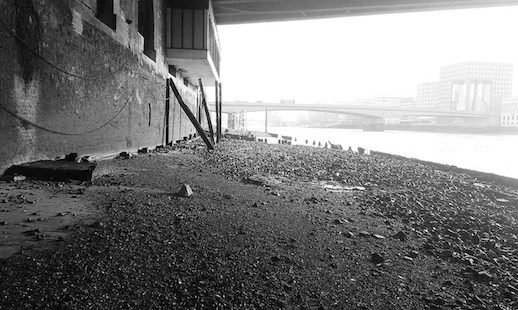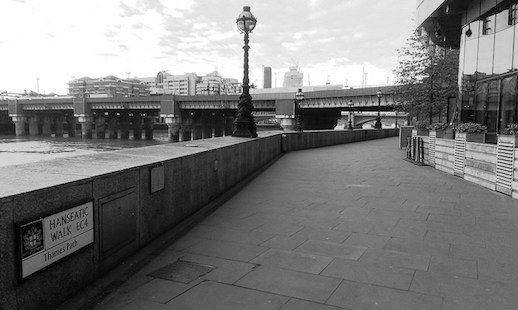Words & pictures: Paul Scraton
Down on the pebbles between the embankment and the Thames as it hurries by beneath the expanse of Cannon Street Railway Bridge, a man with a metal detector picked his way across the stones as I shielded my eyes from the sunlight reflecting from the glass face of the Shard on the opposite bank of the river. Scattered around me were black rocks and frayed ropes; the sound was that of dripping pipes and the rumble of a train above. A few moments before I had been walking along the embankment, attempting to pick my way through a crowd of shirts and trouser suits sipping coffee and inhaling cigarettes on a mid-morning break at the foot of an office tower. Now I stood in the damp shadows, alone apart from the beachcomber who studiously ignored my presence.
Five hundred years ago there was a jetty at this point, a place where ships docked to load and unload their goods into the walled confines of the ‘Steelyard’. The boats came from destinations across the North and Baltic Seas. Bergen and Stockholm. Hamburg and Riga. Lübeck and Stralsund. All these cities were, in some way, connected to the Hanseatic League, a confederation of free cities and associates that dominated trade, and thus helped shape society and politics in northern Europe for about four hundred years.
The Hanseatic League was established in 1358, finally disbanded in 1862, and held its last ever meeting almost two hundred years earlier in 1669. But in all those cities mentioned and more, traces of it remain. It can be found in the red-brick Gothic architecture common to many ports along the Baltic shore. Its legacy is reflected in the fact that Hamburg and Bremen are both city-states in the German Federal Republic. And it gives a name to Rostock’s football team, although their descent down the leagues in recent years is reminiscent more of the Hanseatic League’s long decline rather than its golden heyday.
In the 14th and 15th centuries the Stahlhof or Steelyard on the banks of the Thames was an outpost of the Hanseatic League, a mix between an embassy and a free-trade zone. The Hanseatic League had other outposts in England, such as at King’s Lynn where a half-timbered warehouse still stands, but London was the biggest, and its role is outlined by Neil MacGregor in his book Germany: Memories of a Nation:
“The Steelyard, a huge walled settlement on the Thames, was effectively a gigantic warehouse. Beside it was the quayside with its crane, where ships brought in German wines and exported woollen cloth. There were meeting rooms and houses and a great hall for the 400 German merchants who lived here. They were in many ways a separate community, self-governing, literally a law unto themselves.”
The Steelyard stood between Cousins Lane and All Hallows Lane, the land now occupied by Cannon Street Station. All physical memory of the Hanseatic outpost was destroyed first by the Great Fire of London and then the arrival of the railway; but when I climbed back up the metal stairs from the stony foreshore and onto the embankment, there were a couple of hints at what was once there.
Beneath the station, the embankment walk passes along Steelyard Passage, an echoey underpass lined with large dumpster bins and, on the day I was there, a collection of abandoned Christmas trees. On the other side of the passage the stretch of the Thames Path is called the Hanseatic Walk. And on the wall of the station building is a little plaque, giving a brief history of the site to anyone who notices it enough to climb the small flight of stone steps to give it a read.
Standing on Hanseatic Walk, leaning against the wall, I looked again across the Thames in the direction of the Shard and along the river in the direction of the sea. I was surrounded by tall buildings of glass and steel, which reminded me that London remains a city of trade and commerce, where deals are done for good and ill. There may be no real traces of Hanseatic London to be found down by the Thames, but it is also a reminder that there have long been links between these lands and those across the channel. The Hanseatic League is part of Germany’s memory as a nation, and in a small way, it is a part of Britain’s as well.
*
Paul Scraton is co-founder and Editor-in-Chief of Elsewhere: A Journal of Place. His book, Ghosts on the Shore: Travels along Germany’s Baltic Coast, will be published by Influx Press in June 2017 and is available to preorder in our shop.

